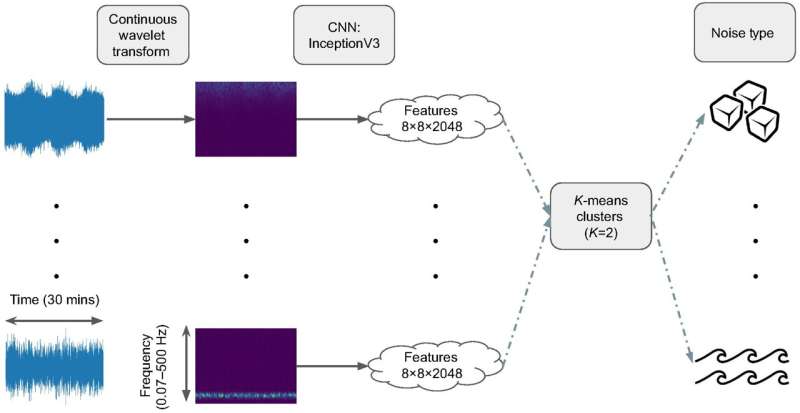This article has been reviewed according to Science X's editorial process and policies. Editors have highlighted the following attributes while ensuring the content's credibility:
fact-checked
trusted source
proofread
Telecommunications cable used to track sea ice extent in the Arctic

A telecommunications fiber optic cable deployed offshore of Oliktok Point, Alaska recorded ambient seismic noise that can be used to finely track the formation and retreat of sea ice in the area, researchers report in The Seismic Record.
Andres Felipe Peña Castro of the University of New Mexico and colleagues used distributed acoustic sensing, or DAS, to identify seismic signals related to the motion of waves on open water and the sea ice that suppresses that wave action. The technique offers a way to track sea ice with increasing spatial and temporal resolution—on the scale of hours and kilometers—compared to satellite images that are updated daily and may cover tens to hundreds of kilometers.
Swiftly monitoring sea ice changes is important to commercial shipping as well as Native communities and could become another useful tool in tracking Arctic climate change, the research team noted.
In the study, the scientists were able to observe abrupt changes in sea ice extent up to 10 kilometers that occurred in less than a day.
"It was definitely surprising that the sea ice can change so much in a few hours," said Peña Castro. "A few colleagues have mentioned that these rapid changes may be common but the temporal resolution of satellites makes it rare to observe such rapid changes in sea ice."
DAS uses the tiny internal flaws in a long optical fiber as thousands of seismic sensors. An instrument called an interrogator at one end of the fiber sends laser pulses down the cable that are reflected off the fiber flaws and bounced back to the instrument. Researchers can examine changes in the timing of the reflected pulses to learn more about the resulting seismic waves.
Peña Castro and colleagues used a 37.4-kilometer-long section of seafloor fiber optic cable, part of a network owned by Quintillion Global and not actively carrying telecom data, in their DAS experiment. The DAS data were recorded between 9-15 July 2021 and 10-16 November 2021, times that were specifically targeted to capture periods of transitional sea ice coverage.
The original idea, said Peña Castro, was to classify different signals emerging from the interaction of ocean, earth and atmosphere, such as potential local sea state and storm surges, shoaling and sea ice fracturing. "We wanted to objectively identify the major types of signals in the data without assuming how many signals or which signals would be dominant," he said. "We did not expect to observe changes in sea ice cover with such fine spatiotemporal detail."
The researchers turned to machine learning algorithms to sort through the massive fiber optic data set. "In general, DAS generates large amounts of data that are impossible to process manually and that's why we opted to use a machine learning approach that can identify possible patterns in the data," Peña Castro explained. "Once a signal or pattern has been identified then we can consider how to track that signal most efficiently."
The researchers were able to observe the formation of sea ice along the length of the cable, but not how far the ice spread perpendicular to the cable. They did not measure sea ice thickness in the study, but Peña Castro said "in theory it is possible to determine ice thickness using DAS. One difficulty is that ground truth measurements of ice thickness are necessary to validate proposed methods."
The combination of machine learning and DAS techniques is already being used in the oil and gas industry, said Peña Castro. "In general, clustering techniques such as those used in this study may help identify lots of different types of change in environmental or anthropogenic signals that create ground vibrations."
More information: Andres Felipe Peña Castro et al, Tracking Local Sea Ice Extent in the Beaufort Sea Using Distributed Acoustic Sensing and Machine Learning, The Seismic Record (2023). DOI: 10.1785/0320230019
Provided by Seismological Society of America



















